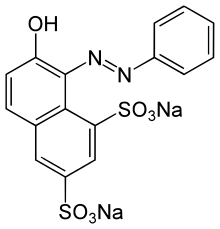Orange G
Orange G also called C.I. 16230,[1] Acid Orange 10,[1] or orange gelb[2] is a synthetic azo dye used in histology in many staining formulations. It usually comes as a disodium salt. It has the appearance of orange crystals or powder.
 | |
| Names | |
|---|---|
| Other names
Acid Orange 10 C.I. 16230 | |
| Identifiers | |
3D model (JSmol) |
|
| ChEBI | |
| ChEMBL | |
| ChemSpider | |
| ECHA InfoCard | 100.016.096 |
| KEGG | |
PubChem CID |
|
| UNII | |
CompTox Dashboard (EPA) |
|
| |
| |
| Properties | |
| C16H10N2Na2O7S2 | |
| Molar mass | 452.38 g/mol |
| Hazards | |
| Main hazards | R36/37/38, S26, S36 |
Except where otherwise noted, data are given for materials in their standard state (at 25 °C [77 °F], 100 kPa). | |
| Infobox references | |
Staining
Orange G is used in the Papanicolaou stain[3] to stain keratin. It is also a major component of the Alexander test for pollen staining.
It is often combined with other yellow dyes and used to stain erythrocytes in the trichrome methods.
Color marker
Orange G can be used as an electrophoretic color marker to monitor the process of agarose gel electrophoresis, running approximately at the size of a 50 Base pair (bp) DNA molecule, and polyacrylamide gel electrophoresis. Bromophenol blue and xylene cyanol can also be used for this purpose. (However, the apparent "size" of all these dyes varies according to the concentration of agarose in the gel and the buffer system used, so one should look up the appropriate reference before using the dyes to determine how far a gel has run.)
pH indicator
Despite its two ionizable groups, it shows only two colors in aqueous solution, brilliant orange in neutral and acidic pH or red in pH greater than 9.
References
- Lillie RD (1974). "The hematoxylin shortage and the availability of synthetic substitutes". Am J Med Technol. 40 (11): 455–61. PMID 4139897.
- Carson, Freida L; Hladik, Christa (2009). Histotechnology: A Self-Instructional Text (3 ed.). Hong Kong: American Society for Clinical Pathology Press. p. 362. ISBN 978-0-89189-581-7.
- Bancroft, John; Stevens, Alan, eds. (1982). The Theory and Practice of Histological Techniques (2nd ed.). Longman Group Limited.